Web Design’s impacts on Content Marketing is one of the most critical subjects for companies nowadays. Each visitor makes a judgment about a website within seconds, and design can break or make your content’s success. When your design works, it enhances your articles, directs the reader, and builds trust. And when it doesn’t, even excellent content will be ignored. This article describes the connection between content and design, why the first impression is crucial, how design enhances readability, and why SEO relies on intelligent design decisions. You will also get real case studies, upcoming trends, and tested lessons.
The Link Between Web Design and Content Marketing

Web design and content marketing are two sides of the same coin. Design shapes how content is seen, while content gives design its purpose. Without clean design, content feels lost. Without content, design feels empty. Both must work together to create value.
Studies show that over 90% of first impressions about a brand relate to design. At the same time, content drives leads, search rankings, and conversions. This makes design the framework that helps content reach the right audience.
You will like this: How Long Does It Take to Learn CSS
First Impressions and Visitor Retention
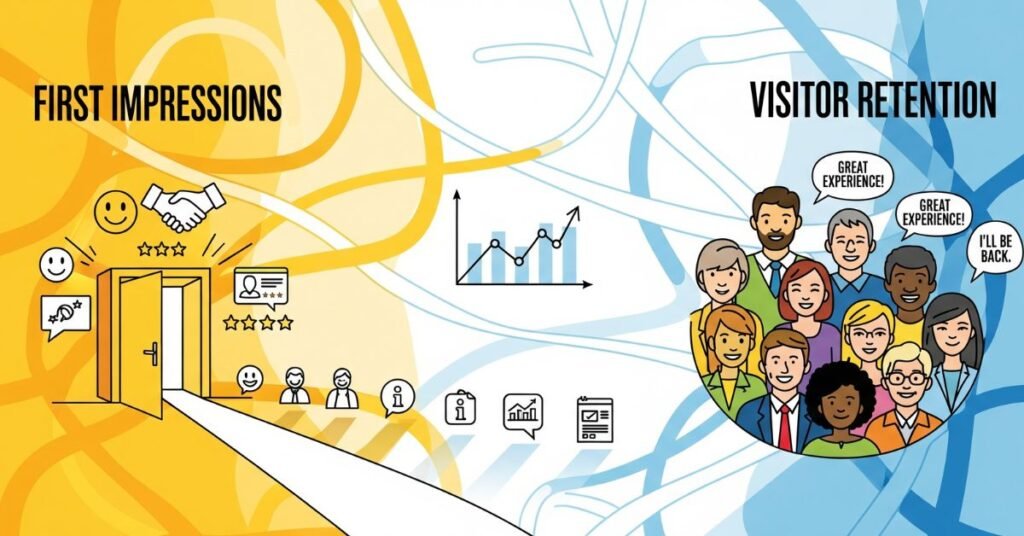
First impressions happen fast. Research shows visitors need only 2.6 seconds to decide whether they trust a website. This is why your design must support your content marketing strategy from the very first moment. Colors, speed, and layout all play a role.
When a website loads slowly or looks outdated, visitors leave without reading a single word. But a clean design with quick load times keeps them engaged. For example, websites with fast loading speeds see up to 70% higher engagement rates.
User Experience (UX) as a Content Delivery System
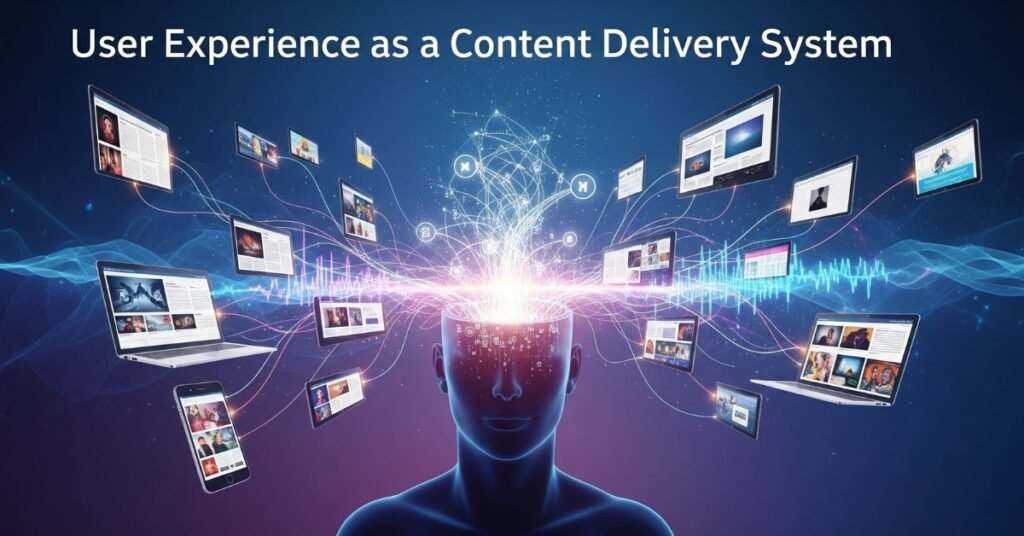
Good design improves user experience, which means readers can find and enjoy content with ease. If menus are confusing or links are hidden, visitors feel frustrated and bounce away. Clear navigation helps highlight important content and makes it easy to explore.
Responsive design is also essential. With more than half of internet users browsing on mobile devices, content must display correctly everywhere. A design that adjusts to small screens ensures your content marketing works for all readers.
Readability and Content Accessibility
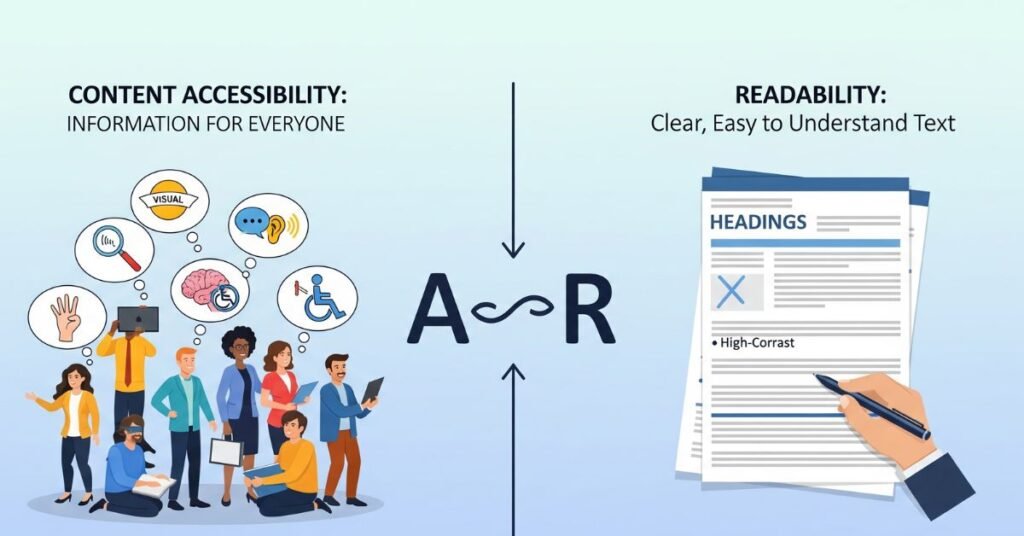
Readers don’t stay if content is hard to read. Design choices such as font size, line spacing, and contrast directly affect readability. Proper white space makes text easy on the eyes, while poor typography discourages visitors from continuing.
Accessibility is just as important. Adding alt text to images, choosing clear fonts, and keeping contrast strong makes content usable for everyone. Inclusive design ensures that your content marketing reaches people with disabilities as well.
Design Elements That Boost Readability
| Design Element | Why It Matters | Impact on Content |
| Typography | Clear fonts keep users reading longer | Improves focus |
| White Space | Reduces visual clutter | Enhances comfort |
| Contrast | Helps text stand out | Aids accessibility |
| Line Length | Prevents eye fatigue | Keeps readers engaged |
Visual Hierarchy and Engagement Flow
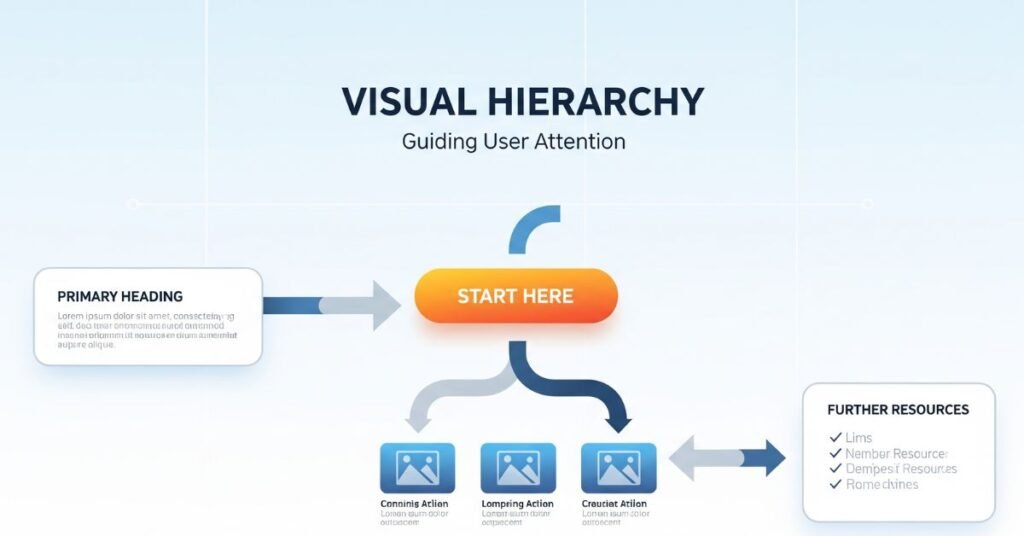
Visual hierarchy is how design guides attention. Strong headings, bold text, and visuals direct the eye toward what matters most. If a website hides calls to action or makes important headlines small, readers miss key messages.
Color and contrast can highlight the right sections. For example, placing a bright call-to-action button near a headline can increase clicks by up to 30%. When design controls flow, readers naturally follow the story the content wants to tell.
Web Design’s Role in SEO and Content Visibility
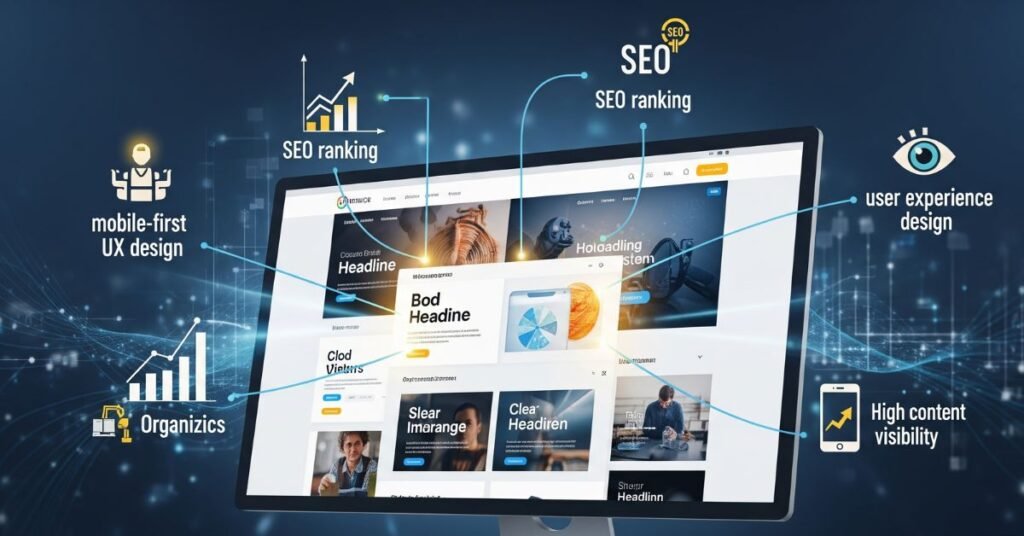
Search engines reward websites that combine content with great design. Page speed, mobile optimization, and Core Web Vitals are ranking factors directly tied to web design. If your site design is heavy, your content marketing suffers in search visibility.
Structured layouts also help crawlers index your pages better. Using schema markup, clean headings, and proper meta placement ensures your content shows up in rich snippets. That means more clicks from organic search.
Read More: What is the Easiest Programming Language to Learn?
Web Design Factors that Affect SEO
| Web Design Factor | SEO Impact | Example |
| Page Speed | Improves ranking and reduces bounce rate | Optimized images, fast hosting |
| Mobile Optimization | Boosts search visibility | Responsive layout on smartphones |
| Core Web Vitals | Signals user satisfaction | Fast loading, no layout shifts |
| Schema Markup | Improves snippet display | Review stars, FAQ schema |
Branding, Trust, and Authority Building
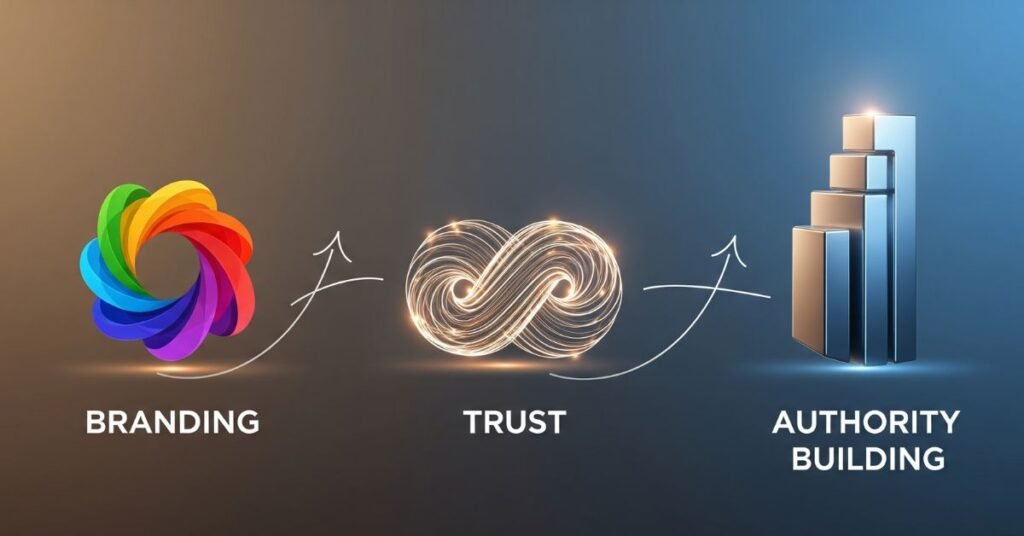
A website is often the first contact point for a new visitor. If the design feels outdated or inconsistent, trust is lost. But when branding elements like colors, fonts, and logos match the brand message, the content gains credibility.
Professional design builds authority. Visitors are more likely to share or trust content from a site that looks reliable. A poorly designed website can make even strong content seem weak, which is why branding must align with content voice.
Encouraging Social Sharing and Distribution

Content marketing depends on distribution, and design plays a big role in it. Placing share buttons where they are easy to see encourages readers to spread content across platforms.
Visual assets also matter. Infographics, videos, and interactive designs get more shares than plain text. A study showed that content with images gains 94% more views than content without them. Design makes sharing effortless.
Case Studies and Real-World Proof

Case studies prove the direct connection between web design and content marketing success. For example, when HubSpot redesigned its blog to improve navigation, content engagement rose by 35%. The redesign helped readers discover more articles and stay longer.
On the other hand, poorly designed websites lose traffic. A 2022 survey found that 38% of users stopped engaging with a site because of unattractive layouts. This shows how design errors destroy even valuable content.
Real-World Case Studies
| Company/Brand | Design Change Implemented | Result on Content Marketing |
| HubSpot | Blog navigation redesign | +35% engagement |
| Airbnb | Mobile-first responsive design | Higher content consumption |
| Local Business | Updated branding and readability | Increased trust and leads |
Future Trends Where Design Meets Content Marketing

The future of content marketing depends on design innovation. AI-driven personalization will adjust layouts and content suggestions for each visitor. This makes design a direct driver of user experience.
Immersive formats are also rising. Minimalist design supports faster reading, while AR and interactive content allow brands to present stories in new ways. This means design will not just support content but shape the way people experience it.
Content Marketing and Web Design A Symbiotic Relationship
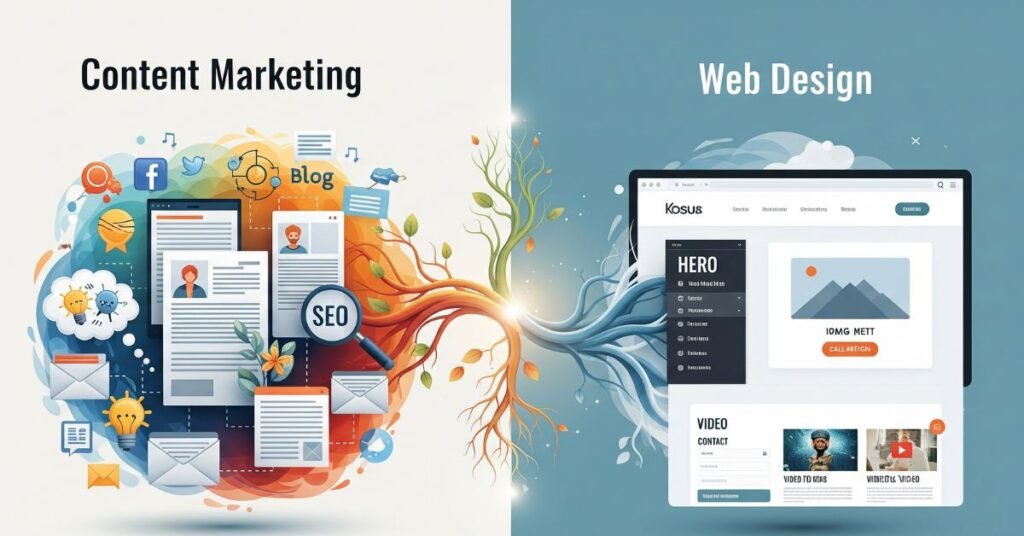
When people talk about content marketing, they often separate it from design. But the truth is they are inseparable. A good article without proper design is like a best-selling book printed in blurry ink. People won’t bother reading. On the other hand, a beautiful design without quality content feels like an empty frame with no picture.
This is why experts describe content and design as symbiotic. Each strengthens the other. A survey by Stanford University found that nearly 75% of users judge a company’s credibility based on its website design. That judgment then extends to how the content is perceived.
The Psychology of Design in Content Marketing

Human psychology plays a key role in how web design impacts content marketing. People are naturally drawn to symmetry, balance, and colors. When design aligns with psychological triggers, content feels more engaging.
For example, warm colors like red or orange encourage urgency and are often used in sales-driven content. Cool colors like blue promote calm and are used in industries like finance or healthcare. Even something as simple as rounded buttons versus square buttons changes how users react to calls-to-action.
Measuring the Impact Analytics and Web Design

It’s not enough to assume design helps content. You must measure it. Analytics tools like Google Analytics, Hotjar, or Crazy Egg show exactly how users interact with content. Heatmaps reveal where readers click, scroll, or stop.
For instance, if users stop reading halfway through a blog, design changes like shorter paragraphs, more visuals, or stronger subheadings can keep them engaged. Content and design optimization must always be guided by data, not guesswork.
FAQ’’S
Why is web design important for content marketing?
Because design controls how content is displayed, read, and trusted. Without good design, even strong content fails to reach readers.
How does web design affect SEO?
Design impacts page speed, mobile performance, Core Web Vitals, and crawlability, all of which are critical SEO factors.
Can poor design reduce content engagement?
Yes. Visitors leave sites that look outdated, cluttered, or slow. Poor design drives high bounce rates.
What design trends support content marketing in 2025?
AI-driven layouts, minimalist design, and immersive content like AR and interactive tools are the key trends.
How do branding and design connect with trust?
Consistent branding in design builds credibility. Visitors trust professional, well-designed sites and engage more with their content.
Conclusion
How Web Design Impacts Content Marketing is clear from every angle. First impressions, SEO, branding, and user experience all depend on strong design. Without it, content marketing loses its power. With it, every article, video, or case study reaches further and delivers better results. The future will demand even closer integration, where design and content work as one system. Businesses that master both will win more trust, more leads, and more growth.




